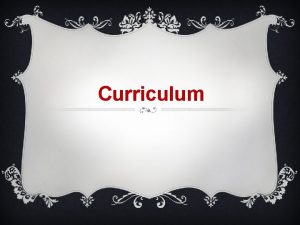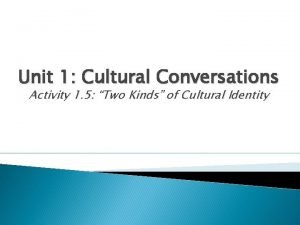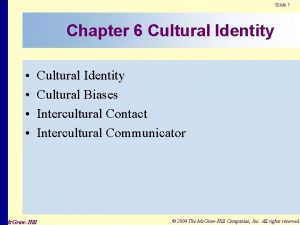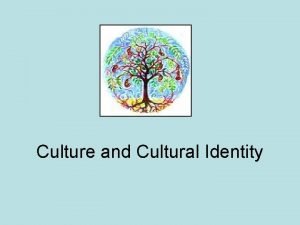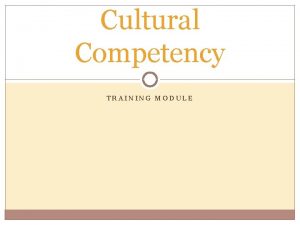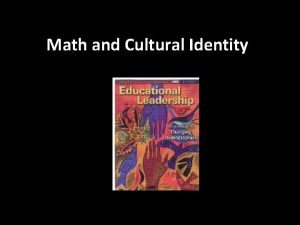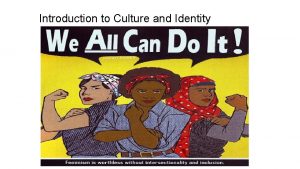Cultural Identity Facets Which Make Up Culture Facets





















- Slides: 21

Cultural Identity Facets Which Make Up Culture

Facets of Culture • Religion • Food • Behaviors – Mannerisms • Apparel – Clothing – Jewelry • Government

Facets of Culture (cont. ) • • Shared History Land usage Language Arts – Music – Poetry – Stories/ myths – Visual Arts

Facets of Culture (cont. ) • • • Values Geography Technology Contacts and trade Economy

First Civilizations – Sumer • Sumerians settle in Tigris Euphrates valley around 4000 B. C. E.

Geography and Climate • Tigris Euphrates River valley – “Fertile Crescent” • River floods each spring leaving behind rich soil. • Little rainfall (led to advances in irrigation) • Such a flat area – very open to invasion

Technology • Civilization largely dependent on advances in 4 th century B. C. E. • Pottery wheel • Irrigation • Wheel • Writing (cuneiform) • Shipbuilding improvements

Technology • Bronze working (around 4000 B. C. E) – Hoes – Plows – Weapons • More technology increased specialization and artisan class • Glass • New about movement of moon and stars

Technology (cont. ) • Sumerian system of numbers based on 12, 60, 360.

Food • Came from agriculture • Increased agriculture technology created a surplus • Could focus on more than survival • Date trees, onions, garlic, etc • Oxen used for farming

Land usage • Land rights and ownership • Agriculture largely led to this concept of private land • Owning land provided incentive for improvements – Irrigation ditches, etc • Difficulty of irrigation led to greater communities

Religion • People buffeted by fate • Gods are temperamental and must be appeased • Built centers of worship and pilgrimage • Elaborately decorated temples for grim gods that ultimately controlled human destiny

Religion (cont. ) • Believed every object in nature should have a separate name to ensure place in universe. Thus, writing quickly took on religious purposes. • Priests controlled writing (mostly done on clay cylinders) • Beliefs greatly influenced later Muslim, Christian and Jewish cultures.

Behaviors • Relied on slave labor • Had vast armies to help protect land

Government • First code of laws comes and records kept – Largely an advance allowed by writing • Based on tightly organized city-states – Urban king with great authority • Ruled agricultural hinterland – Local councils to advise the king – Helped define boundaries/ land use • Kings and priests had control • Regional rule

Government Cont. • Connected to religion

Shared History • Can be seen in epic story of Gilgamesh

Arts • First book: Epic Poem Gilgamesh – Adapted from oral poem – Hero does good deeds but often bumps up against the gods. • Art often had a somber tone • Large Ziggurats were monumental architecture with religious purpose.

Values • Increased stratification of social rank

Contacts and trade • Traded food and good • Adopted silver as a means of buying and selling • Traded with lower Persian Gulf to western Mediterranean and to India

After the decline of Sumer • Sumerian culture greatly influenced later Akkadian and Babylonian cultures
 Facets of culture
Facets of culture 6 facets of learning
6 facets of learning Facets of curriculum
Facets of curriculum Facets of formative assessment
Facets of formative assessment Facet model of advertising
Facet model of advertising Five factor model facets
Five factor model facets Wi facets
Wi facets Six facets of light
Six facets of light Miller orr model assumptions
Miller orr model assumptions Identity icebreaker
Identity icebreaker Cultural identity development models
Cultural identity development models Cultural identity development models
Cultural identity development models Unexamined cultural identity stage
Unexamined cultural identity stage Ruiz's chicano/latino ethnic identity model
Ruiz's chicano/latino ethnic identity model Two kinds of cultural identity activity 1.5 answer key
Two kinds of cultural identity activity 1.5 answer key Cultural identity context clue
Cultural identity context clue Cultural identity
Cultural identity Cultural identity
Cultural identity Why is culture identity important
Why is culture identity important Why is culture identity important
Why is culture identity important Relativism
Relativism Sociologists define a symbol as
Sociologists define a symbol as


